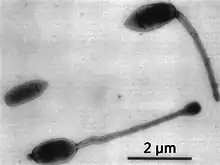Hyphomicrobium
Hyphomicrobium is a genus of Gram-negative, non-spore-forming, rod-shaped bacteria from the family of Hyphomicrobiaceae.[1][2][3][4][5][6] It has a large polar or sub-polar filiform prostheca very similar to that of Caulobacter. In addition to having a nutritional function, the prostheca also plays a role in the initiation of DNA replication.
| Hyphomicrobium | |
|---|---|
 | |
| Scientific classification | |
| Kingdom: | |
| Phylum: | |
| Class: | |
| Order: | |
| Family: | |
| Genus: | Hyphomicrobium Stutzer and Hartleb 1899[1] |
| Type species | |
| Hyphomicrobium vulgare[1] | |
| Species | |
|
H. aestuarii | |
Reproduction in Hyphomicrobium begins when its hyphal filament (prostheca) grows from one end of the cell (this happens when the cell no longer has a flagellum) and the bud grows from the tip of the prostheca that eventually differentiates into a new swarmer cell.
References
- LPSN lpsn.dsmz.de
- UniProt
- Urakami, T.; Sasaki, J.; Suzuki, K. -I.; Komagata, K. (1995). "Characterization and Description of Hyphomicrobium denitrificans sp. nov". International Journal of Systematic Bacteriology. 45 (3): 528. doi:10.1099/00207713-45-3-528.
- Vuilleumier, S.; Nadalig, T.; Farhan Ul Haque, M.; Magdelenat, G.; Lajus, A.; Roselli, S.; Muller, E. E. L.; Gruffaz, C.; Barbe, V.; Medigue, C.; Bringel, F. (2011). "Complete Genome Sequence of the Chloromethane-Degrading Hyphomicrobium sp. Strain MC1". Journal of Bacteriology. 193 (18): 5035–6. doi:10.1128/JB.05627-11. PMC 3165642. PMID 21868803.
- Rainey, F. A.; Ward-Rainey, N.; Gliesche, C. G.; Stackebrandt, E. (1998). "Phylogenetic analysis and intrageneric structure of the genus Hyphomicrobium and the related genus Filomicrobium". International Journal of Systematic Bacteriology. 48 (3): 635–9. doi:10.1099/00207713-48-3-635. PMID 9734017.
- Characterization and Description of Hyphomicrobium denitripcans sp. nov.